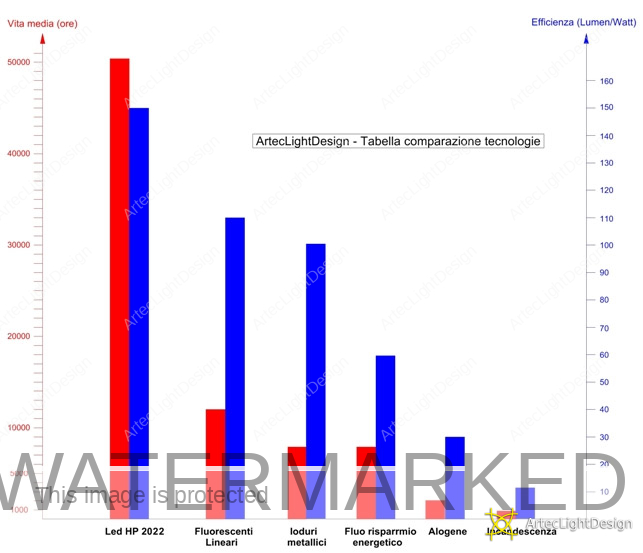Technologies
Incandescent/halogen/fluorescent/discharge lamps vs Led lamps.
Not so long ago, Led technology wasn’t as a fact suitable for general lighting, not being the level of brightness strong enough to the cohabitation with other conventional lighting fixtures, with halogen or fluorescent or discharge technology, much brighter.
But the last generation Led have brilliantly overcome the problem, in particular for applications in which the colorful light is necessary.
Systems made with conventional lamps must filter the white light to get colours, losing great part of the emitted power, whereas the Led sources directly emit colored light, without substantial wasting of power.
But also for general lighting the current white High Power Led are winning, as it looks evident in the chart here beside.
If an incandescent light bulb turns into heat 90% of the supplied energy, converting in light 10% only, a High Power Led turns into light beyond 90% of the supplied energy, with evident energetic and ethical advantage.

Moreover, the flux emission of Led is directional, therefore all the emitted flux flows towards the working surface, whereas all the other sources waste an important percentage of the emitted flux in unwanted directions, even using back reflectors to recover efficiency.
Life time (from 50.000 to 100.000 hours) is another winning feature of Led, pulling dramatically down the relevant maintenance costs.
It is however necessary to pay attention as these life times are possible just by using very well designed equipments.
The quality of the Led source is very important, as well as the current feeding and the cooling systems: features of low cost fixtures, with poor power supply and cooling systems, decay very quickly, either in terms of brightness and of chromatic stability.
Serious manufacturers of Led equipments give warranty that their Led will keep not less than 80% of the starting features over their average life span.
Inside high quality fixtures there is an electronic constant current feeding system - inner or remote - that guarantees an automatic adaptation to whichever line voltage, making the life time of the Led source independent from the quality of the main voltage (that instead influences enormously both the halogen lamps and the low cost Led lamps).
Low cost fixtures use out-off-date Led, with low lumen/watt efficiency (50lumen/watt), therefore if compared to the last generation High Power Led 100/150 lumen/watt) they are much less brighter, despite the same power input.
Further peculiarity of Led technology is the low tension and low temperature working, increasing safety and reliability, as well as the absence of intrinsically delicate filaments and glass bulbs/tubes.
Led doesn’t emit ultraviolet and infrared rays, doesn’t contain polluting elements (like the mercury of many fluorescent/discharge lamps), therefore its use and future removal have low environmental impact.
The color rendering index (Ra/Cri) of high quality Led lamps led can be >90, therefore also suitable to all those contexts where the perfect perception of colours is important.
